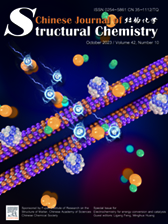
Cover Picture
Modulating metal-support interaction between Pt3Ni and unsaturated WOx to selectively regulate the ORR performance
Jinli Chen, Shouquan Feng, Tianqi Yu, Yongjin Zou, Huan Wen*, Shibin Yin* Submit a Manuscript
Modulating metal-support interaction between Pt3Ni and unsaturated WOx to selectively regulate the ORR performance
Jinli Chen, Shouquan Feng, Tianqi Yu, Yongjin Zou, Huan Wen*, Shibin Yin* Submit a Manuscript
Fe–N–C nanostick derived from 1D Fe-ZIFs for electrocatalytic oxygen reduction
Jiayu Huang, Kuan Chang, Qi Liu, Yameng Xie, Zhijia Song, Zhiping Zheng, Qin Kuang*
Chin. J. Struct. Chem., 2023, 42: 100097. DOI: 10.1016/j.cjsc.2023.100097
October 15, 2023
Oxygen reduction reaction; Metal-organic frameworks; M–N–C catalysts; Electrocatalysts
ABSTRACT
The slow oxygen reduction process at the cathode and the scarcity of platinum-based metals lead to limited applications in fuel cells and metal-air cells. Recently, transition metal and nitrogen co-doped carbon-based catalysts (M–N–C) are regarded as the most prospective non-precious metal catalysts for future fuel cell applications. It is verified theoretically and experimentally that the metal and nitrogen coordination structure is the main catalytic activity center of oxygen reduction reaction (ORR), so constructing M–N–C materials with high available surface area and structural stability is an effective way to accelerate ORR. Herein, we deliberately synthesize a one-dimensional ZIF structure to fabricate one-dimensional porous Fe–N–C nanostick via two-step pyrolysis. Excitingly, the as-synthesized exhibited an outstanding ORR activity in alkaline medium (E1/2 of 0.928 V), as well as superior stability (only changed 7 mV after 10,000 cycles in alkaline medium). Our results show that the reduction of electrocatalyst dimensionality can promote mass transport and increase the accessibility of active sites, thus optimizing their performance in ORR. This work is a good demonstration of the importance of a rational design of catalyst structure for efficient ORR.







